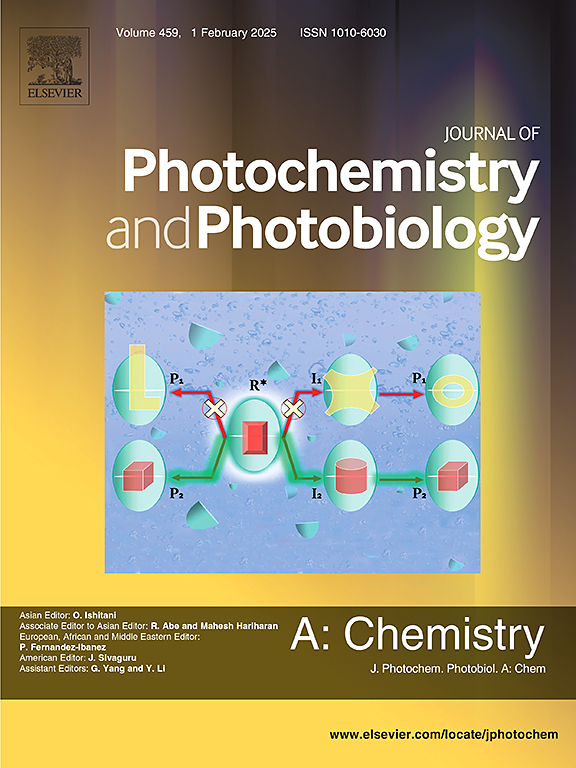Nitrogen/sulfur dual-doped porous carbon microtubes prepared from poplar catkins as high-performance counter electrode of dye-sensitized solar cells
IF 4.1
3区 化学
Q2 CHEMISTRY, PHYSICAL
Journal of Photochemistry and Photobiology A-chemistry
Pub Date : 2025-06-08
DOI:10.1016/j.jphotochem.2025.116561
引用次数: 0
Abstract
The fabrication of low-cost counter electrode using heteroatom-doped porous carbon derived from renewable biomass is a promising strategy to assemble cost-effective dye-sensitized solar cells (DSCs). Here, nitrogen/sulfur dual-doped porous carbon microtubes (NSPCMTs) are prepared by a direct pyrolysis process using poplar catkins as the carbon source and thiourea as the nitrogen (N) and sulfur (S) source. It is found that the as-prepared NSPCMTs inherit the microtube morphology of poplar catkins and the thiourea addition results in the dual-doping of N and S and promotes the pore formation on the wall of carbon microtubes. The obtained NSPCMTs display a specific surface area of 379.55 m2 g−1. The N/S dual-doping and the high surface area enhance the surface accessibility and increase the electrocatalytic active sites of NSPCMTs, which endows NSPCMTs with a superior electrocatalytic performance. Cyclic voltammetry and electrochemical impedance spectroscopy measurements indicates that NSPCMT electrode has the same electrocatalytic activity as conventional Pt electrode. Consequently, the DSC with NSPCMT electrode demonstrates an efficiency of 8.27 %, approaching to the performance of Pt electrode-based cell.

杨柳絮制备氮/硫双掺杂多孔碳微管作为染料敏化太阳能电池的高性能对电极
利用来自可再生生物质的杂原子掺杂多孔碳制备低成本对电极是一种极具成本效益的染料敏化太阳能电池(dsc)。本文以杨柳絮为碳源,硫脲为氮(N)和硫(S)源,采用直接热解法制备了氮/硫双掺杂多孔碳微管(NSPCMTs)。研究发现,制备的nspcts继承了杨柳絮的微管形态,硫脲的加入导致N和S的双掺杂,促进了碳微管壁上的孔形成。所得nspcmt的比表面积为379.55 m2 g−1。N/S双掺杂和高比表面积增强了NSPCMTs的表面可及性,增加了NSPCMTs的电催化活性位点,使NSPCMTs具有优异的电催化性能。循环伏安法和电化学阻抗谱测试表明,NSPCMT电极具有与常规Pt电极相同的电催化活性。结果表明,nspmt电极的DSC效率为8.27%,接近Pt电极电池的性能。
本文章由计算机程序翻译,如有差异,请以英文原文为准。
求助全文
约1分钟内获得全文
求助全文
来源期刊
CiteScore
7.90
自引率
7.00%
发文量
580
审稿时长
48 days
期刊介绍:
JPPA publishes the results of fundamental studies on all aspects of chemical phenomena induced by interactions between light and molecules/matter of all kinds.
All systems capable of being described at the molecular or integrated multimolecular level are appropriate for the journal. This includes all molecular chemical species as well as biomolecular, supramolecular, polymer and other macromolecular systems, as well as solid state photochemistry. In addition, the journal publishes studies of semiconductor and other photoactive organic and inorganic materials, photocatalysis (organic, inorganic, supramolecular and superconductor).
The scope includes condensed and gas phase photochemistry, as well as synchrotron radiation chemistry. A broad range of processes and techniques in photochemistry are covered such as light induced energy, electron and proton transfer; nonlinear photochemical behavior; mechanistic investigation of photochemical reactions and identification of the products of photochemical reactions; quantum yield determinations and measurements of rate constants for primary and secondary photochemical processes; steady-state and time-resolved emission, ultrafast spectroscopic methods, single molecule spectroscopy, time resolved X-ray diffraction, luminescence microscopy, and scattering spectroscopy applied to photochemistry. Papers in emerging and applied areas such as luminescent sensors, electroluminescence, solar energy conversion, atmospheric photochemistry, environmental remediation, and related photocatalytic chemistry are also welcome.

 求助内容:
求助内容: 应助结果提醒方式:
应助结果提醒方式:


